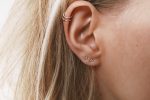When I was about 20, I decided to get dermal implants along my hip bones.
I’d previously had my navel pierced, but I did a crappy job of taking care of it, and I eventually took it out because it was gross (part infection, part my shitty, flappy sugar-belly). I thought dermal implants would be a neat alternative because they were, and still are, pretty rare piercings, and I could easily hide them.
Unfortunately, my one mistake in this whole situation was I never accounted for how high I wear my pants. Flappy sugar-belly plus low-rider jeans makes me look like Meg from “Family Guy.” As a result, I wear my pants super high (you know, the kind of high-rise pants you could also tuck your boobies into). I also don’t have a waist, so even normal pants tend to sit higher up on my body (other short-waisted goblin girls share my pain).
Long story short, I pretty much spent the next six months or so routinely catching these goddamn things on every piece of clothing I owned. Eventually, the jewelry migrated out — every time a dermal gets pulled really hard, it brings the post closer to the surface of the skin — but of course only one end migrated out. So one part of the post was totally healed and affixed under my skin, and the other was poking out.
My mom’s solution—she was in medical school at the time and had just received a fresh batch of scalpels—was to cut the other end out without administering anything other than some disinfectant. I aided in this pseudo-surgery by screaming. In the end, we should’ve just gone to a piercer and had him/her remove them (really—you don’t need a doctor, or your friendly home surgeon, to take them out).
This whole bizarre scenario aside, I really like dermal implants, just not on my torso. I know a lot of people hear the word “implant” and become concerned about how invasive the piercing is. In some cases, the word “implant” is said and the inconsiderate person you kind of love and live with thinks you mean breast implants and wholeheartedly encourages you to get them.
Either way, I can say with no uncertainty that a dermal piercing is significantly less invasive than breast implants (mainly because no one is repositioning your nipples to avoid crocked teets).
I’ll go ahead and say that, if you’re a first-time piercee, don’t do a dermal implant.
They’re difficult to take care of, they get snagged and pulled easily, and they have a tendency to reject (the body naturally pushing out the foreign object). And if you’re under 21, don’t get dermal implants. I know, I know — at 18, you’re an “adult” and as an “adult,” you can do what you want. I agree, but dermal implants — like a face, neck or hand tattoo — can’t be hidden, and the scarring is fairly significant.
Implants and Procedures
There’re actually two types of dermal implants you can get, but 99 percent of the time, if you say “dermal implants,” the piercer will know you mean “microdermal implants.” Transdermal implants are more invasive and really hardcore. I wouldn’t recommend transdermal implants to anyone other than folks with face tattoos because a face tattoo says “I’m up for anything — even transdermal implants.”
Microdermal implants, or just dermal implants, are less invasive. I have two of them on my face: One above my eyebrow and one next to my eye. I had a third on my cheek, but I pulled my pants up too high and ripped it out (just kidding — I snagged it on a towel when washing my face).

When I went for my dermal implants (and generally speaking), the piercer marked the spot for the implant, had me confirm it, then began to massage/roll the skin between his fingers to soften it. He then poked a hole into the skin, slid the post in, and — probably the worst part of it — twisted the post into place. None of it really hurts until the brutal twisting which feels weirdly like carpet burn underneath the skin. T
he twisting is necessary, however, in order to clear away the tissue. New tissue will grow through the holes in the post, which will anchor the dermal implant into the skin. After the post is in place, the piercer will then screw a piece of jewelry—usually a colored bead, but there are stars, flowers, spikes, etc. — into the post.
At that point, you really should cover the piercing for about three months until it’s totally healed to avoid snagging it. But everyone knows that literally no one is going to do that, so just be extra careful, especially when you’re drunk and blindly wiping your face with a shitty towel.
Aftercare
Clean around the jewelry with warm, salty water (1 tsp sea salt + 8 oz of distilled water + a few seconds in the microwave) at least three times a day, but no more than six.
If your dermal is on your face and you wear makeup, don’t put makeup on it. In fact, just avoid putting cosmetics on that area of your face at all. You can gently lotion around it, but really try to leave a wide area of untouched skin wherever it is.
When you shower, wash the area with soap. Don’t be a fool — use regular, old soap. No acne wash or scrubs, even if it’s that super-organic Trader Joe’s brand ultra-special millet-vegan-okay-to-apply-directly-inside-your-retinas soap.
Throw that freaking loofah away. I know you love your loofah, but that loofah will be worse for your dermal than a nursing home full of incredibly conservative and very judgmental old people.
Wherever your dermal is, gently pat it dry with your towel.
Pretend it’s a little baby kitten with a very unstable neck and hemophilia, and you’ll do great.
Moisturize with Vitamin E after the dermal has healed a little! Buy a bottle of Vitamin E capsules, poke a hole in one, and squeeze a drop of oil onto a q-tip or directly onto the dermal. It’ll keep the skin moist which is good because the salt water will dry it out.
Some Common Questions (Plus My Shitty Answers)
Q: AHHH! There’s a weird red bump right next to my jewelry and stuff is coming out of it when I squeeze it! Is it infected?
A: Nah, you’re probably fine. Grab your handy salt water and a cotton ball, and soak it for about 20 minutes. If you can, try to gently press on the bump to express the gooey inside, you gross person.
Q: I also have a weird red bump right next to my jewelry, but when I press it, nothing comes out, and it feels like there’s something hard/pokey under the bump.
A: Did you snag it?
Q: Yes, of course I snagged it. I wash with a loofah.
A: Throw the loofah away and go to your piercer. He/she needs to reset the jewelry. Whenever you snag or catch your jewelry, you move the post a little closer to the surface of your skin. If you can feel the post pressing against the skin, go to your piercer! If you don’t, the post will migrate out and worsen your scarring. (Also, it hurts like a bitch)
Q: I can’t get this piece of jewelry to screw in to the post, and I’ve been trying for the past decade.
A: I have no advice here. Just know that putting in different jewelry is really, really frustrating because you’re dealing with tiny metal pieces.
Q: I just had my dermal removed, and I’m worried about the scarring.
A: The scarring is the main reason I caution people against getting dermal implants. Unlike the small pinprick scar common of most piercings, dermal scars can be fairly sizable and, if not cared for properly, form divots in the skin.
My best advice: After you have the post removed, wait for the area to scab (about two days) and then begin massaging the crap out of it with Vitamin E oil. It’ll really help with the scarring! Once the scar has more or less “set” (meaning, that’s as good as it’s getting), apply a cream with Retin-A to the area.
And that’s all you’ll ever need to know about dermal implants. Always go to a reputable piercer, and never let a dermal be your “on a whim” piercing. Save those whims for neck and face tattoos and scary Craigslist hook-ups.














